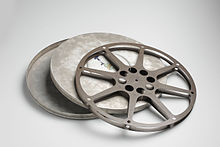|
Reel
  A reel is a tool used to store elongated and flexible objects (e.g. yarns/cords, ribbons, cables, hoses, etc.) by wrapping the material around a cylindrical core known as a spool. Many reels also have flanges (known as the rims) around the ends of the spool to help retain the wrapped material and prevent unwanted slippage off the ends. In most cases, the reel spool is hollow in order to pass an axle and allow it to spin like a wheel, a winding process known as reeling, which can be done by manually turning the reel with handles or cranks, or by machine-powered rotating via (typically electric) motors. ConstructionThe size of the core is dependent on several factors. A smaller core will obviously allow more material to be stored in a given space. However, there is a limit to how tightly the stored material can be wound without damaging it and this limits how small the core can be. Other issues affecting the core size include:
With material such as photographic film that is flat and long but is relatively wide, the material generally is stored in successive single layers. In cases where the material is more uniform in cross-section (for example, a cable), the material may be safely wound around a reel that is wider than its width. In this case, several windings are needed to create a layer on the reel. Uses Examples of reel usage include:
Motion picture terminology  It is traditional to discuss the length of theatrical motion pictures in terms of "reels". The standard length of a 35 mm film reel is 1,000 feet (305 m), which runs approximately 11 minutes for sound film (24 frames per second)[2] and about 15 minutes for silent film at the more or less standard speed of 18 frames per second.[3] Most films have visible cues which mark the end of the reel. This allows projectionists running reel-to-reel to change over to the next reel on the other projector. A so-called "two-reeler" would have run about 15–24 minutes since the actual short film shipped to a movie theater for exhibition may have had slightly less (but rarely more) than 1,000 ft (305 m) on it. Most modern projectionists use the term "reel" when referring to a 2,000-foot (610 m) "two-reeler", as modern films are rarely shipped by single 1,000-foot (305 m) reels. A standard Hollywood movie averages about five 2,000-foot reels in length. The "reel" was established as a standard measurement because of considerations in printing motion picture film at a film laboratory, for shipping (especially the film case sizes) and for the size of the physical film magazine attached to the motion picture projector. If it had not been standardized (at 1,000 ft or 305 m of 35 mm film), there would have been many difficulties in the manufacture of the related equipment. A 16 mm "reel" is 400 feet (122 m). It runs, at sound speed, approximately the same amount of time (11–12 minutes) as a 1,000-foot (305 m) 35 mm reel. A "split reel" is a motion picture film reel in two halves that, when assembled, hold a specific length of motion picture film that has been wound on a plastic core. Using a split reel allows film to be shipped or handled in a lighter and smaller form than film would on a "fixed" reel. In the silent era, the term was used to describe a single reel that accommodated two or more individual titles. As digital cinema catches on, the physical reel is being replaced by a virtual format called Digital Cinema Package, which can be distributed using any storage medium (such as hard drives) or data transfer medium (such as the internet or satellite links) and projected using a digital projector instead of a conventional movie projector. A newsreel is a short documentary film. A showreel or demo reel is a short film showcasing a person's or organization's previous work. See alsoReferences
External links
|